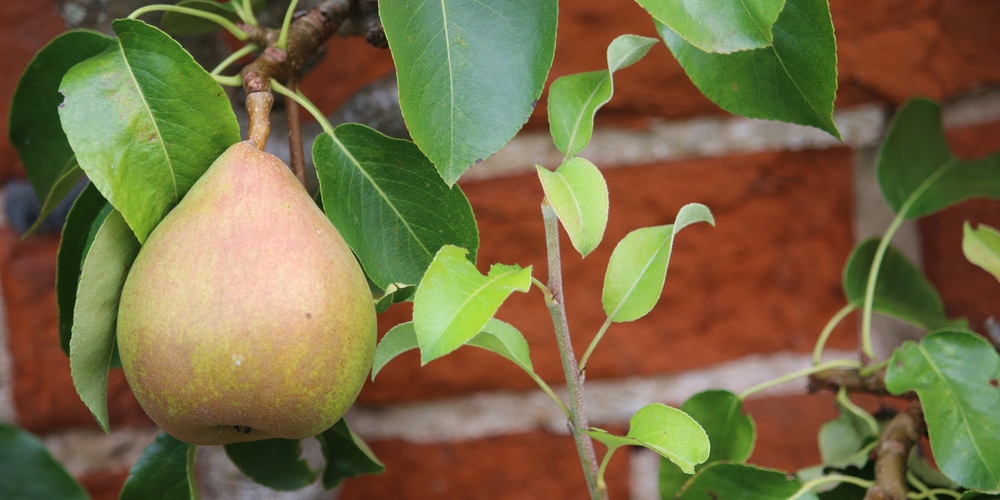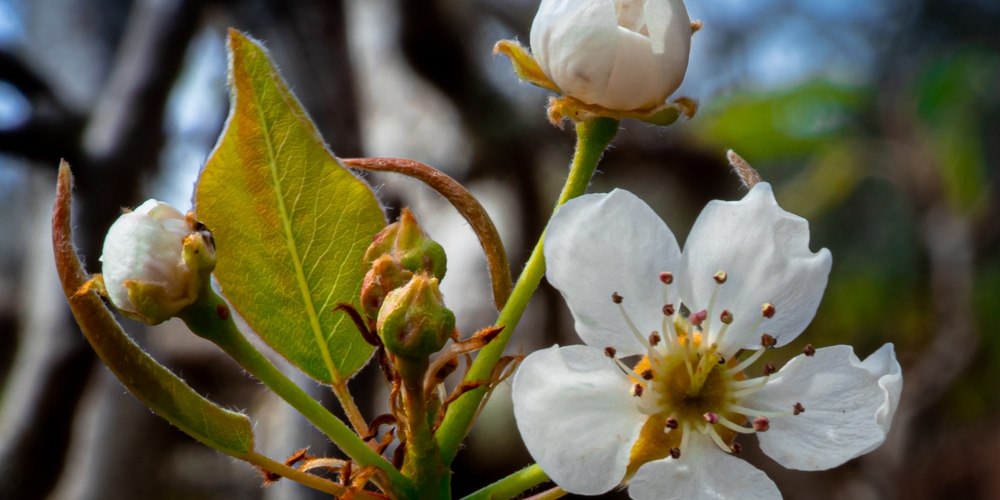A premium pear cultivar, ‘Christmas Pear’ Dwarf Comice Pear Tree boasts outstanding fruit flavor and is native to France.
| Botanical Name | Pyrus communis ‘Comice’ |
| Common Name | Common pear |
| Plant Type | Perennial |
| Flower Color | Small white flowers that turn into fruit |
| Size When Mature | 180 inches |
| Bloom Time | Spring |
| Sun Requirements | Full sun |
| USDA Hardiness Zones | 5 to 9 |
| Soil PH Range | 6.0 to 7.0 |
| Soil Type | Well-drained, slightly acidic |
| Water Needs | Medium |
| Native Area | France |
What you Need to Know About Dwarf Comice Pear Tree
Pyrus communis ‘Comice’ is similar to its regular-sized pear tree counterpart, Pyrus communis except that it’s shorter. However, the fruit size and taste are the same. The pear tree species is a heavy fruit producer as long as optimal growing conditions are met.
The Dwarf Comice Pear Tree’s leaves are unassuming, with the flower buds and fruits being the main draw of growing the tree in your yard. ‘Doyenne du Comice’ pears are superbly delicious and juicy, with the fruit having rounded bodies sporting a bright green color with streaks of pink and light red on the skin.
How to Care for Dwarf Comice Pear Tree
Here’s everything you need to know about growing and caring for a thriving Dwarf Comice Pear Tree
Light
Dwarf Comice Pear Trees enjoy being in a location that gets full sun. A minimum of six hours of direct and unfiltered sunlight is best for the pear tree’s health and so it can produce an abundance of fruits.
The pear tree species will not appreciate being in shade and won’t likely produce flowers if planted in a shady area. Since Dwarf Comice Pear only grows up to 15 feet high you can easily pick the right spot in your yard or garden to support maximum growth.
Water and Soil Needs
You might think that a tree that produces succulent and juicy fruits would need frequent watering, but this isn’t the case with the Dwarf Comice tree. Those who live in warmer regions will appreciate the tree’s drought-tolerant characteristics and won’t need to water as much.
As a general rule, you should only water when the soil is completely dry. The tree doesn’t like waterlogged and frequently moist soil and can still grow even when you miss an irrigation or two. As far as soil pH is concerned, the optimal pH level is 6.5, which is slightly acidic.
Dwarf Comice Pear Tree is best planted in well-drained and loamy soil that’s rich in organic matter. Make sure to amend the soil with plenty of organic compost to give your tree a growth boost, especially in its early stages.
Temperature Requirements
Dwarf Comice Pear Tree is best grown in USDA zones 5 through 9. Unfortunately, it won’t be able to survive outside the recommended zones because the tree doesn’t like cold winters and searing summers.
Spring is the best season to plant Comice Pear for zones 5 to 6, those who live in zones 7 to 9 can plant the common pear starting fall through spring.
Fertilizer
The best fertilizer to use on a Dwarf Comice Pear Tree is a balanced fertilizer applied every two to three months during its growing season.
A 13-13-13 NPK or nitrogen phosphorus and potassium mix should suffice. Feed your pear plants before the bud breaks, but not in late summer or fall as the buds and growth will likely get damaged by frost.
Spread the fertilizer roughly about 6 inches away from the trunk and in a circle along the drip line. Make sure to water the fertilizer into the soil thoroughly to make it available for your plants.
Common Diseases
In general, pear trees are susceptible to several diseases, including fire blight, leaf spot, pear scab, and blotches. In the pest department, you’ll have to look out for codling moths, pear psyllas, aphids, and spider mites.
Pear trees affected by fire blight will need to be cut down to around 8 inches. Leaf spots and scabs can be treated with fungicide sprays and by observing best sanitation practices. To treat the pests you can spray your tree with dormant oil products specially made to fix the problem.
Dwarf Comice Pear Tree Propagation
Dwarf Comice Pear Tree can be propagated via cuttings or grafting. When done this way you’ll preserve the original species and can enjoy the same type and variety of fruit.
Multiplying pear trees will give you more fruits once all of the plants mature. Take several softwood cuttings that are around six to eight inches in length, remove the lower leaves and stick them in a well-drained potting soil mix. Place the container where it gets bright and indirect light and in a warm environment, and you’ll soon see growth in a month or two.
Related Article: Zone 6 Fruit Trees


